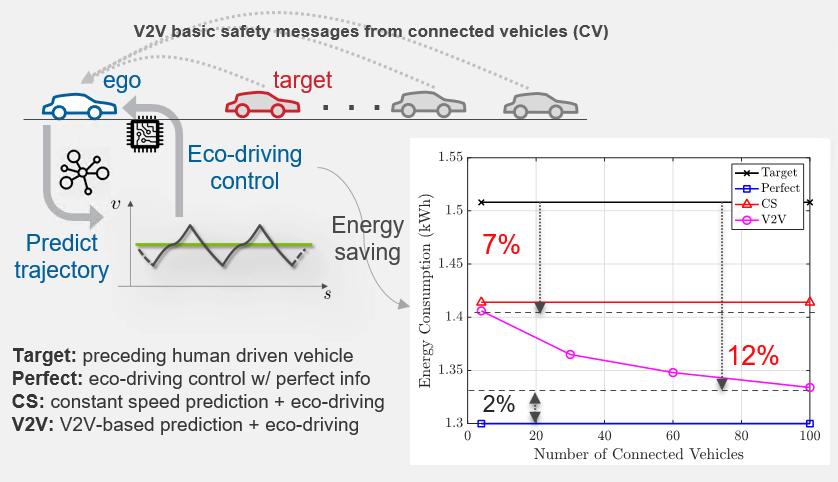V2V Energy Savings
Published: 2024 January
Vehicle-to-Vehicle Communications Help Automated Vehicles Save 7-12% Energy Thanks to Better Knowledge of Future
Enabling live communication between passenger vehicles can reduce energy consumption by up to 12% in highway scenarios, according to a study conducted by Argonne National Laboratory.
Wireless communication between vehicles on the road, also known as vehicle-to-vehicle (V2V) connectivity, refers to technologies enabling real-time data exchange between vehicles, such as current speed and location. V2V connectivity has the potential to revolutionize the transportation industry by improving safety and reducing traffic congestion. V2V communication can also enhance vehicle energy efficiency by extending the look-ahead horizon of the vehicles. However, despite its potential benefits, V2V communication still faces challenges in terms of early adoption pathways, mainly due to low market penetration.
In order to explore the potential energy benefits of an extended V2V network, researchers at Argonne National Laboratory assessed the energy consumption of V2V-enabled autonomous vehicles over large-scale traffic.1 The autonomous vehicles were driven by an energy-optimal controller that minimizes longitudinal acceleration by forecasting an immediately preceding vehicle’s trajectory over a fixed prediction horizon. Simulations were designed by adopting a human driver model generating stable car-following trajectories for many consecutive vehicles using Argonne’s multi-vehicle powertrain simulator, RoadRunner. In addition, various traffic scenarios were considered including different car-following behaviors, number of V2V-enabled vehicles, and optimal control parameters. Results show that autonomous vehicles can save energy by 7-12% compared to human-driven vehicles, mainly depending on the V2V penetration.
The study demonstrates that V2V communication can significantly improve vehicle energy efficiency; however, the availability of V2V communication on the road is crucial to achieve the energy savings.
 Figure 1. In the simulation, the objective is to improve the energy efficiency of the connected and automated vehicle (“ego” in the figure) thanks to a better prediction of the preceding (“target” in the figure) vehicle speed using basic safety messages from the downstream vehicles and uses these messages to predict the future speed of the target vehicle (labeled “V2V” in the graph). Results show that 7% energy savings can be achieved at 20% penetration and 12% with full penetration.
Figure 1. In the simulation, the objective is to improve the energy efficiency of the connected and automated vehicle (“ego” in the figure) thanks to a better prediction of the preceding (“target” in the figure) vehicle speed using basic safety messages from the downstream vehicles and uses these messages to predict the future speed of the target vehicle (labeled “V2V” in the graph). Results show that 7% energy savings can be achieved at 20% penetration and 12% with full penetration.
The study was funded by the US Department of Energy (DOE) Vehicle Technologies Office (VTO) Energy Efficient Mobility Systems (EEMS).
-
Hyeon, E., Han, J., Shen, D., Karbowski, D., Kim, N., & Rousseau, A. (2022). Potential Energy Saving of V2V-Connected Vehicles in Large-Scale Traffic. IFAC-PapersOnLine, 55(24), 78-83. DOI: 10.1016/j.ifacol.2022.10.265. ↩︎